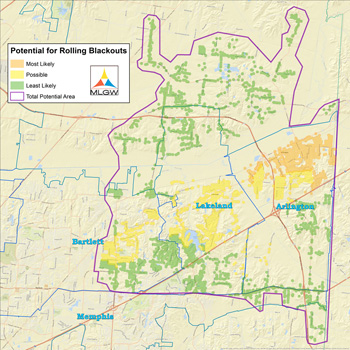Focal point remains Arlington and Lakeland
The forecasted extreme temperatures for next week increase the likelihood of rolling blackouts during the peak hours of 3 p.m. and 8:30 p.m. in Arlington, Lakeland and surrounding areas that are impacted by the loss of service from Substation 68.
Rolling blackouts, which are unprecedented in recent MLGW history, are intended to balance power loads and protect the electric distribution system from damage that could result from the high demand for power caused by the extreme heat until Substation 68 returns to service on or before August 8. If needed, blackouts, lasting about 4 hours, would rotate between sections—not entire cities—in order to balance power loads during peak hours.
 |
| Click image to view full size |
The accompanying map shows Substation 68 transformers in orange and yellow. Orange notes the “most likely” transformers that would be impacted by rolling blackouts, if needed. Yellow notes where rolling blackouts are “possible.” Green-colored transformers are “least likely” to experience rolling blackouts but are in the voluntary curtailment because their related substations are providing power to Substation 68’s service area.
Customers who are “most likely” to be affected by rolling blackouts will receive notice via phone starting Sunday.
By voluntarily curtailing power usage, customers can minimize the impact of rolling blackouts. Here are some tips for residential and commercial customers.
Residential customers:
• Raise your thermostat setting to minimize air conditioner operation. An 80-degree setting will have the greatest benefit to balancing the system and avoiding blackouts, but even a few degrees may help. Wear light-colored, loose fitting clothes and drink cool beverages to maintain comfort.
• Install a programmable thermostat, if you don’t already have one. Program the system to raise indoor temperatures between 3:00pm and 8:30pm. Read your owner’s manual or manufacturer’s website carefully to see whether the device has “intelligent recovery,” which means it really activates earlier so you reach the desired setting by the programmed time. You want the system to begin resuming normal operation at 8:30pm.
• Plan shopping and entertainment during the 3:00pm to 8:30pm period, so you won’t notice the higher temperature in your home.
• Use ceiling fans and portable fans to provide supplemental cooling, but be sure to turn off fans if no one is in the room. (Fans stir the air to speed evaporation on your skin; they do not lower the actual room temperature.)
• Delay energy-intensive activities—such as laundry, dishwashing and extensive cooking—until after 8:30pm. Prepare meals in the microwave, which uses less energy than your stove or oven.
• Close curtains and blinds on west-facing windows and doors. Keep exterior doors tightly closed and make sure storm windows are lowered.
• Check and replace any torn weatherstripping along exterior door frames and windows. Those little cracks enable hot air to invade your home, causing discomfort and longer air conditioner run times.
• Turn off unnecessary electronics. Plugging them into a surge protector strip with an on/off switch makes this task simple. This includes TVs, game consoles, computers, monitors, speakers and printers.
• Unplug chargers after use. Phone chargers and other devices that convert AC power to DC power continue to use small amounts of power, even if the device is not connected.
• Run pool pumps earlier in the day or later in the evening to avoid the peak hours of 3:00pm to 8:30pm.
COMMERCIAL
• Raise thermostat settings to 80 degrees during business hours. (Yes, it will be warm, but will help avoid blackouts.) If 80 degrees is impossible, raise it as much as you can. Set thermostat even higher after hours to minimize energy use until 8:30.
• Encourage employees to dress casually for comfort.
• Use personal fans to provide supplemental cooling in key areas to offset some of the thermostat change. Remember to turn off fans when leaving the area.
• Reduce lighting in hallways, meeting rooms, restrooms, parking garages and office spaces. Use natural lighting or lower-wattage task lighting to compensate until close of business, then minimize further as employees and customers leave the property.
• Ask employees to turn off office equipment, fans, task lighting and other personal electronics at the end of their workday. Computers, monitors, printers and seldom-used fax machines are frequent overnight power draws.
• Check the breakroom for small appliances and electronics that run unnecessarily and turn them off. You may need to post signs to encourage users to “turn it off” when finished.
• Post signs to encourage employees to take the stairs instead of elevator, if they are able.


